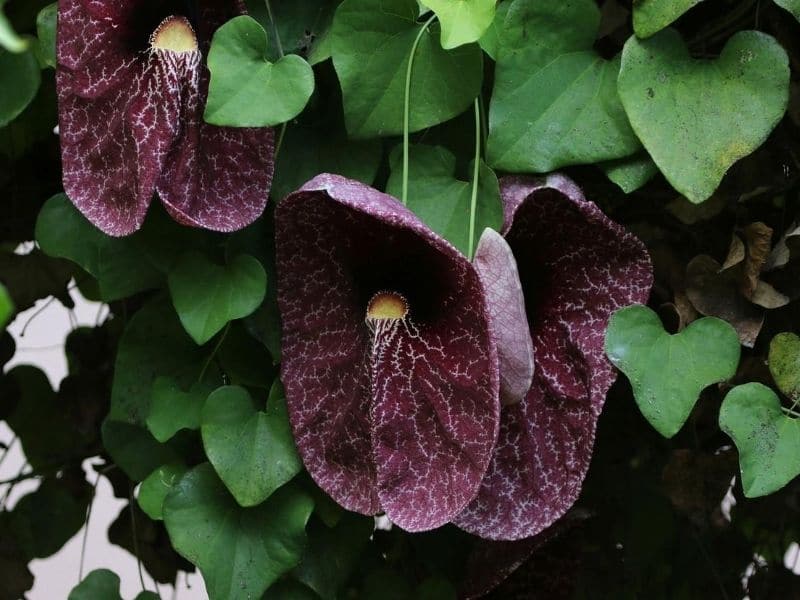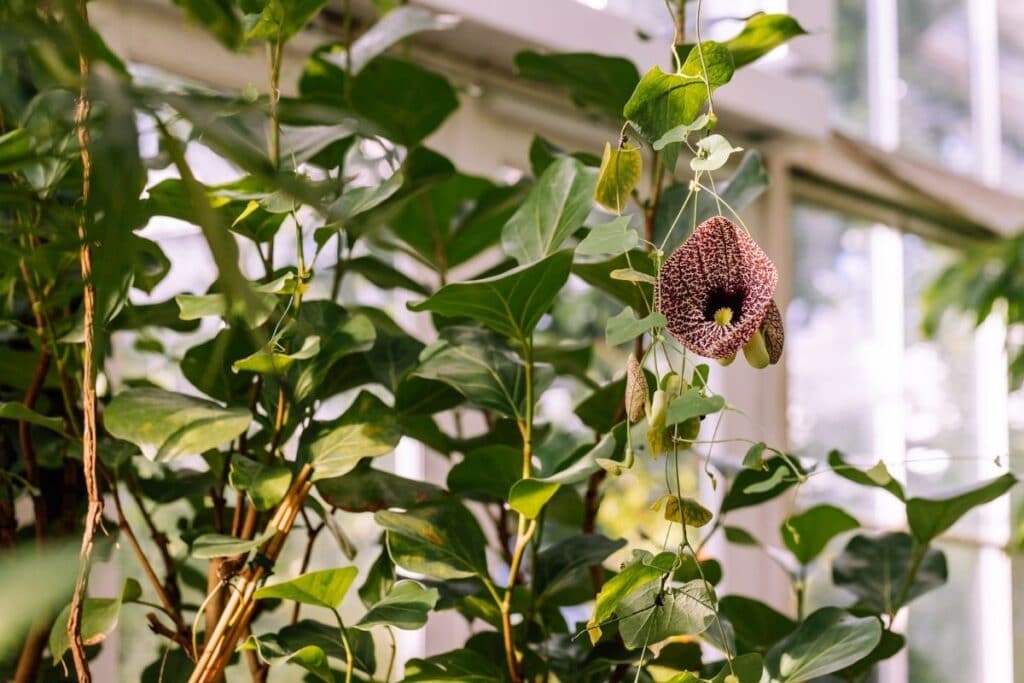In a garden where privacy is highly favored, vines with broad leaves and aggressively growing will work perfectly. The Dutchman’s pipe is one of the top plants to use for the aforementioned function.
Read on to know more about growing and caring for this vine and how to place it in a landscape design.
Botanical Information
Aristolochia macrophylla is the scientific name of the Dutchman’s Pipe and is a combination of greek and Latin words that will give a clue as to what this vine looks like. The genus, Aristolochia, is an amalgamation of the Greek words “Aristos” and “locheia” translating to best and childbirth respectively.
The genus describes the vine’s flowers, which look like an unborn child. On the other hand, the specific epithet is a Latin word that translates to large heart shaped leaves.
Moreover, this vine garnered a variety of common names as it flourishes in different parts of the world. Its common names involve Dutchman’s pipe vine, broadleaved birthwort, wild ginger, and pipevine.
One of its common names, Dutchman’s pipe vine, was coined due to a similar appearance of its blooms. Each flower looks like a Meerschaum pipe, a common smoking pipe in Europe.
Spatial Distribution
This perennial broadleaf vine is a native from the southwestern parts of Pennsylvania and Alabama and Georgia highlands. In those said locations, this plant commonly grows in fertile woodlands and near bodies of water.
Moreover, this fast growing vine became widely used in different landscapes in USDA Zones 4 to 8 resulting in naturalization in northern and eastern parts of the USA.
Growth Habits
As a fast-growing perennial vine, the Dutchman’s pipe vine can reach 20 to 75 feet in height and 15 to 20 feet in width. This vine can go to lengths thanks to its specialized root structures called rhizomes.
As a plant commonly seen in moist woodlands or areas near streams, the Dutchman’s pipe vine could take over any landscape, spreading all around and competing with existing vegetation. This might harm an ecosystem if left unruled.
On the other hand, the dutchman’s pipe vines are not that bad, as it is the primary source of nutrition for pipevine swallowtail butterfly larva. Also, hummingbirds seem to be fond of this vine’s nectar. Some insects are attracted to their blooms and help in the pollination process.
Leaves
One of the Dutchman’s pipe vine’s main selling points is its luscious green broad leaves. It resembles the appearance of a heart, a foot long, smooth, deep green on top, and silver-gray under.
Flowers
Looking for this vine’s flowers may be tricky since it is often covered with dark green leaves. Its inconspicuous flowers are visible in early summer, around May to June. Hence, people can see fetus-shaped or smoking pipe-shaped flowers with yellow-green base color with hints of brown and purple in the lobes.
It also gives off a pungent smell that some compare to spoiled meat. This is used by the plant to attract insects as pollinators.
Fruit and Seeds
At the fruit set, flowers give rise to pods that are green when young but change their color to grayish-brown to black at maturity.

How Grow Dutchman’s Pipe Vines
Sun Requirement
The Dutchman’s pipe vine is a versatile and sturdy plant that loves to be exposed to full sun. Although, it could also flourish when planted in partial shade.
Water Requirement
This climbing vine tolerates different moisture levels, from low to high. When this plant is already established, watering is performed once a week.
Temperature and Humidity
As a sun-loving plant, it flourishes under warm and moist conditions. Also, it proves its sturdiness as it tolerates cold temperatures up to 25 degrees Fahrenheit.
Soil Requirement
Since the Dutchman’s pipe vine is often spotted near streams and in woodlands, it shows that they highly favor a moist and rich planting medium. They should be planted in soils that have good drainage and have a pH ranging from 5 to 7.
Furthermore, this pipevine needs space to grow and not disrupt other plants. It is recommended to have a 1 to 2.5 meters planting distance away from other plants.
Remember to not let their soil dry up, since they will not survive long dry periods. Also, this vine is sensitive to strong winds, which is why they need materials, like fences and trellises, for anchorage.
Fertilizer Requirement
As long as the Dutchman’s pipe vine is planted in an organic material-rich environment, frequent application of fertilizer is not needed. Although, the application of complete fertilizer during spring will help the plant grow more leaves and bloom.
Avoid over-fertilizing to not disrupt the pH balance and availability of soil nutrients.
Maintenance Activities
There are two main maintenance activities to optimize the growth of the Dutchman’s pipevine, training, and pruning. Both of these actions are performed to give the vine an aesthetically pleasing shape while serving its function in a landscape.
Training involves providing a good supporting material for the pipevine to cling on. They are often left to grow near a fence, a wall, or a trellis that are strong enough to support the plant’s weight and help break strong winds with minimal damage.
Furthermore, pruning goes hand in hand with training. By removing dead plant parts and outgrowths, the vine retains its shape while promoting the growth of new shoots.
Regular pruning is done during late winter because the perennial vines become dormant and might not be able to sustain much foliage. Aside from this regular schedule, the Dutchman’s pipe vine may be pruned as often as needed.
Propagation
The Dutchman’s pipe vine is propagated in two major ways, by seeds and stem cuttings. If sowing seeds is the chosen method, harvest time is during the last weeks of summer.
Check the capsules if they have dried up and cracked open, then collect the seeds. After doing so, sow them indoors in seed beds or containers. Gradually expose the seedlings to sunlight and warm environments.
On the other hand, stem cuttings are preferred by many due to faster results. Cuttings of healthy, mature and actively growing stems are collected during early spring. Then, the cut tips are submerged in a transparent or glass container with water to let them develop roots. Clear containers are recommended to see when the cuttings are ready to be planted.
After the plant has developed a good root system, plant it in well-drained soil and water frequently until established.

Functions In The Landscape
Vines with compact foliage, like the Dutchman’s pipe vine, are ideal for serving as a privacy screen in a garden. Aside from letting it crawl onto trellises and fences for the screen, it can also be used to soften the look of houses and buildings by incorporating it in green walls, greens roofs, or vertical gardens.
In roofs or tunnels, this vine can give an illusion of a bridal train as its dense foliage descends. Hence, this dense vine is perfect for providing shade and privacy in any landscape.
Potential Harm
As beautiful as this vine may be, the Dutchman’s pipe brings potential harm for the landscape users. This is because the species under Aristolochia have aristolochic acid, which causes digestive and kidney problems upon ingestion.
Fortunately, the pipevine swallowtail butterfly is not affected by this. Another potential harm it may bring is fire accidents due to it being highly flammable. This is why they should be placed at a reasonable distance away from a house.
Knowledge about this plant should be used to plant the landscape design properly. Remember to take into consideration the use of the landscape, existing man-made structures and plants, and the requirements for this vine to flourish.
To prevent any accident caused by the Dutchman’s pipe vine, plant it in a strategic location and avoid planting it near smoking areas, cooking areas, and children’s playgrounds.
FAQs
Why is my Dutchman’s pipe dying?
Dutchman’s pipe (Aristolochia species) may be dying due to various reasons, including overwatering, underwatering, poor soil drainage, pests, diseases, or environmental stressors like extreme temperatures or insufficient sunlight. Assessing factors such as watering practices, soil condition, and environmental conditions can help determine the cause.
Does Dutchman’s pipe grow fast?
Yes, Dutchman’s pipe tends to grow moderately fast once established, especially in favorable growing conditions with adequate direct sunlight, water, and nutrients. It can cover arbors, fences, or trellises relatively quickly with its vigorous growth habit.
How do you start a Dutchman’s pipe vine?
You can start a Dutchman’s pipe vine from seeds or stem cuttings. To start from seeds, sow them in a well-draining potting mix and keep them consistently moist until germination occurs. For stem cuttings, take a cutting from a healthy, mature vine, remove the lower leaves, and place the cutting in a pot with moist soil to root.
Can you grow Dutchman’s pipe from a cutting?
Yes, Dutchman’s pipe can be grown from stem cuttings. Take a cutting from a healthy portion of the vine, remove the lower leaves, and dip the cut end in rooting hormone to promote root development. Plant the cutting in a pot with well-draining soil and keep it consistently moist until roots form.
How do you propagate a pipe vine?
To propagate a Dutchman’s pipe vine, you can use methods such as seed sowing, stem cuttings, or layering. Seed sowing involves planting seeds in a potting mix and providing appropriate conditions for germination. Stem cuttings involve taking a cutting from a healthy vine and rooting it in soil or water. Layering involves burying a portion of a vine stem in soil to encourage root development before detaching it from the parent plant.
See more: Purple flower vine plants
*image by ursaminorph/depositphotos






